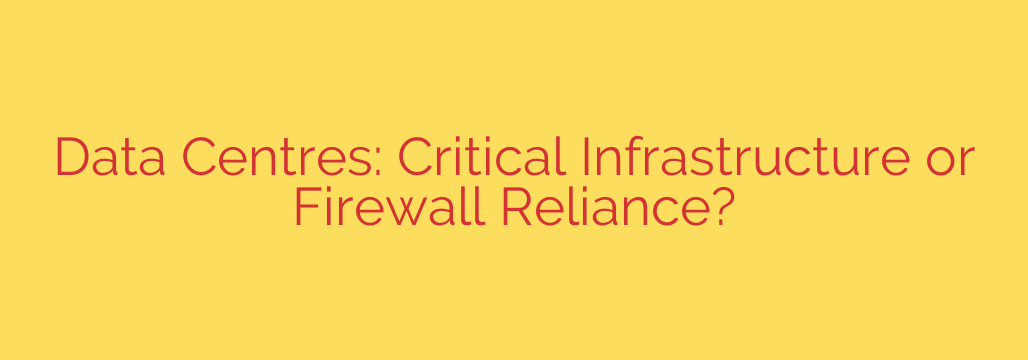
Is Your Data Center Truly Secure? Moving Beyond the Firewall Myth
Data centers are the beating hearts of our digital world. They house the critical servers, storage, and networking equipment that power everything from global finance to our social media feeds. Often described as “critical infrastructure,” they are physically fortified with high fences, 24/7 security personnel, and biometric scanners. But does this physical security create a dangerous illusion of complete cyber resilience?
While these physical measures are essential, the reality is that a data center’s security is far more complex than its concrete walls and locked doors. The assumption that a strong perimeter firewall is enough to protect the valuable assets within is an outdated and hazardous oversimplification. True data center security requires a deep, multi-layered strategy that treats the internal network with as much suspicion as the outside world.
The Problem with Perimeter-Only Defense
For years, the standard security model was the “castle and moat” approach. The data center was the castle, and the firewall was the moat, designed to keep intruders out. Anything inside the moat was considered trusted and allowed to communicate freely.
This model is fundamentally broken in the modern era. Attackers are more sophisticated, and threats can originate from anywhere. Relying solely on a perimeter firewall leaves an organization dangerously exposed to several critical risks:
- Insider Threats: A malicious employee or a contractor with legitimate access can cause immense damage, as the internal network often lacks sufficient controls.
- Compromised Credentials: If an attacker steals a user’s login details through phishing, they can bypass the firewall and gain trusted access to the internal network.
- East-West Traffic: A significant amount of traffic within a data center moves laterally, from server to server (known as east-west traffic). A perimeter firewall has no visibility or control over this internal communication, allowing malware to spread unchecked once inside.
- Misconfigurations: A single misconfigured server or application can create a backdoor for attackers, rendering the powerful perimeter defenses useless.
Simply put, once the perimeter is breached—and it often is—a firewall-reliant security posture offers little resistance to an attacker moving freely within the network.
Building a Truly Resilient Data Center Security Strategy
Protecting a modern data center means moving away from the “trust but verify” mindset and adopting a more rigorous, proactive approach. This involves layering multiple security controls and assuming that a breach is not a matter of if, but when.
Here are actionable steps to build a more robust and resilient security posture for your critical infrastructure.
1. Embrace a Zero Trust Architecture
The core principle of Zero Trust is simple: never trust, always verify. This model eliminates the idea of a trusted internal network. Every user, device, and application must be authenticated and authorized before accessing any resource, regardless of its location. This means a compromised server cannot freely communicate with a critical database next to it without being re-authenticated and validated.
2. Implement Micro-segmentation
Micro-segmentation is a powerful technique for enforcing Zero Trust principles. It involves dividing the data center network into small, isolated zones, down to the individual workload level. Security policies are then applied to each zone, strictly controlling what traffic can move between them. If one workload is compromised, micro-segmentation contains the breach, preventing the attacker from moving laterally across the network to access other valuable assets.
3. Ensure Continuous Monitoring and Visibility
You cannot protect what you cannot see. Gaining deep visibility into all network traffic—especially the internal east-west traffic—is paramount. Advanced monitoring and threat detection tools can help security teams:
- Identify anomalous behavior that could indicate a breach.
- Map application dependencies to create more effective security policies.
- Respond to incidents faster by pinpointing the source of an attack.
4. Prioritize Vulnerability and Patch Management
Software vulnerabilities are one of the most common entry points for attackers. A rigorous and timely patch management program is not optional; it is a fundamental security requirement. Regularly scanning for vulnerabilities across all servers, applications, and network devices and applying patches promptly closes the doors that attackers rely on to get inside.
The Bottom Line: Security is a Process, Not a Product
Data centers are indeed critical infrastructure, but this designation does not grant them inherent immunity from cyber threats. Their security cannot be guaranteed by a strong physical presence or a powerful firewall alone.
True data center resilience is achieved through a dynamic, intelligent, and layered security posture. By adopting a Zero Trust mindset, implementing micro-segmentation, and maintaining constant vigilance, organizations can build a defense-in-depth strategy that protects their most valuable data—not just at the perimeter, but at its very core.
Source: https://datacentrereview.com/2025/08/are-we-treating-data-centres-like-cni-or-just-hoping-firewalls-will-do/








